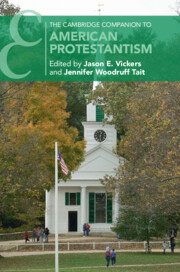Book contents
- The Cambridge Companion to American Protestantism
- Cambridge Companions to Religion
- The Cambridge Companion to American Protestantism
- Copyright page
- Dedication
- Contents
- Contributors
- Acknowledgments
- Introduction
- Part I Historical Overview
- Part II The Religious Culture of American Protestantism
- Part III Theological Traditions
- 17 Anglicanism
- 18 The Reformed Tradition
- 19 The Lutheran Tradition
- 20 Brethren and Mennonite Traditions
- 21 Baptists
- 22 The Stone-Campbell Movement
- 23 Wesleyan-Methodist and Holiness Traditions
- 24 Pentecostalism
- Selected Bibliography
- Index
- Cambridge Companions to Religion (continued from page ii)
24 - Pentecostalism
from Part III - Theological Traditions
Published online by Cambridge University Press: 11 May 2022
- The Cambridge Companion to American Protestantism
- Cambridge Companions to Religion
- The Cambridge Companion to American Protestantism
- Copyright page
- Dedication
- Contents
- Contributors
- Acknowledgments
- Introduction
- Part I Historical Overview
- Part II The Religious Culture of American Protestantism
- Part III Theological Traditions
- 17 Anglicanism
- 18 The Reformed Tradition
- 19 The Lutheran Tradition
- 20 Brethren and Mennonite Traditions
- 21 Baptists
- 22 The Stone-Campbell Movement
- 23 Wesleyan-Methodist and Holiness Traditions
- 24 Pentecostalism
- Selected Bibliography
- Index
- Cambridge Companions to Religion (continued from page ii)
Summary
There are three broad types of Pentecostalism: first, Classical Pentecostalism, which emerged from the overflow of the Azusa Street revival in Los Angeles (1906-1909) and led to the founding of denominations like the Assemblies of God, the Church of God, and the Church of God in Christ; second, the Charismatic Movement, which arose in the early 1960s and took shape within long-established Christian traditions, both Catholic and Protestant; and third, Neo-Pentecostalism or the Neo-Charismatic Movement, which constitutes the post-denominational and largely indigenous “Third Wave” of renewal. Pentecostals coalesce around a focus on Jesus; a flow of praise; a thirst for the Scriptures; an expectation of God’s present-day speaking and acting; an urgency in mission; an awareness of the powers of evil; the use of charismatic gifts, including tongues, healing, and prophecy; a fervent expectation of the Parousia; and a commitment to the renewal of the churches through the life-giving power of the Spirit.
- Type
- Chapter
- Information
- The Cambridge Companion to American Protestantism , pp. 461 - 478Publisher: Cambridge University PressPrint publication year: 2022

